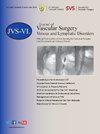Frequency of left common iliac vein compression in asymptomatic adolescents and young adults
IF 2.8
2区 医学
Q2 PERIPHERAL VASCULAR DISEASE
Journal of vascular surgery. Venous and lymphatic disorders
Pub Date : 2025-06-20
DOI:10.1016/j.jvsv.2025.102282
引用次数: 0
Abstract
Objective
Venous compression at the iliac confluence is a reported risk factor for deep vein thrombosis, with venous stenting as the standard management for relieving this compression. Kibbe et al demonstrated that left common iliac vein (LCIV) compression is present in 35.3% of asymptomatic patients. However, this study included only adults with an average age of 40 years. The iliac vein confluence in patients under 21 years with no symptoms attributable to venous disease was evaluated in this study. The study goal is to determine prevalence of LCIV narrowing in patients under age 21 years, and as such, assist in determining the appropriate treatment for iliac vein compression in this patient population.
Methods
A retrospective review of patients aged 13-20 undergoing abdominal/pelvic computed tomography (CT) imaging for nonvascular indications was performed. This group was compared with patients aged 35 to 65 years undergoing CT imaging for similar reasons. Axial CT images were reviewed by two independent examiners to identify the diameter of the noncompressed left and right CIVs below the confluence and the diameter of the LCIV at the site of compression between the right common iliac artery and spine.
Results
A total of 122 patients aged 13 to 20 years were identified with high-quality CT imaging and no venous symptoms for image review. Mean LCIV diameter was 12.7 ± 2.5 mm, and mean right CIV diameter was 13.1 ± 2.2 mm. The diameter of the LCIV at the confluence was 4.2 ± 1.8 mm, resulting in a mean diameter stenosis of the LCIV of 69.4% ± 12.6%. In this population, 55.7% of patients were found to have ≥70% stenosis of the LCIV on CT imaging compared with 1.7% of patients aged 35 to 65 years (P < .001). There was no statistical difference in the percentage of LCIV stenosis in young patients based on body mass index, gender, race, or ethnicity.
Conclusions
Severe compression of the LCIV at the iliac confluence was identified in over 50% of asymptomatic patients aged 13 to 20 years on CT imaging performed for nonvascular reasons. This suggests that narrowing of the LCIV is a normal anatomic finding in this age group. The incidence of severe compression is significantly lower in older asymptomatic persons. In young persons, the high incidence of iliac vein compression on CT imaging suggests that this finding may not be a significant risk factor for deep vein thrombosis or limb symptoms, questioning the need for routine intervention for compression correction in this patient population.
无症状青少年和青壮年左髂总静脉受压的频率。
目的:据报道,髂汇合处静脉压迫是深静脉血栓形成(DVT)的危险因素,静脉支架置入术是缓解这种压迫的标准方法。Kibbe等人证明,35.3%的无症状患者存在左髂总静脉(LCIV)压迫。然而,这项研究只包括平均年龄为40岁的成年人。本研究评估了21岁以下无静脉疾病症状患者的髂静脉汇合情况。该研究的目的是确定21岁以下患者LCIV狭窄的患病率,因此,有助于确定该患者群体中髂静脉压迫的适当治疗方法。方法:回顾性分析13-20岁接受腹部/盆腔CT检查的非血管指征患者。将这组患者与35-65岁因类似原因接受CT成像的患者进行比较。由2名独立检查人员复查轴位CT图像,以确定汇合处以下未受压的左右civ的直径以及右侧髂总动脉与脊柱之间受压部位的LCIV的直径。结果:122例年龄13-20岁的患者均有高质量的CT成像,影像学复习无静脉症状。左髂总静脉(LCIV)平均直径12.7±2.5 mm,右髂总静脉平均直径13.1±2.2 mm。汇合处LCIV直径为4.2±1.8 mm,平均狭窄率为69.4%±12.6%。在该人群中,55.7%的患者CT成像发现LCIV狭窄≥70%,而35-65岁患者的这一比例为1.7% (P < .001)。基于体重指数、性别、种族或民族,年轻患者LCIV狭窄的百分比没有统计学差异。结论:在13-20岁的无症状患者中,超过50%的患者在非血管原因的CT成像中发现髂汇合处LCIV严重压迫。这表明LCIV变窄在这个年龄组是正常的解剖发现。老年人严重压迫的发生率明显较低。在年轻人中,髂静脉压迫在CT成像上的高发表明,这一发现可能不是深静脉血栓形成或肢体症状的重要危险因素,这就质疑了在这一患者群体中进行常规干预以纠正压迫的必要性。
本文章由计算机程序翻译,如有差异,请以英文原文为准。
求助全文
约1分钟内获得全文
求助全文
来源期刊

Journal of vascular surgery. Venous and lymphatic disorders
SURGERYPERIPHERAL VASCULAR DISEASE&n-PERIPHERAL VASCULAR DISEASE
CiteScore
6.30
自引率
18.80%
发文量
328
审稿时长
71 days
期刊介绍:
Journal of Vascular Surgery: Venous and Lymphatic Disorders is one of a series of specialist journals launched by the Journal of Vascular Surgery. It aims to be the premier international Journal of medical, endovascular and surgical management of venous and lymphatic disorders. It publishes high quality clinical, research, case reports, techniques, and practice manuscripts related to all aspects of venous and lymphatic disorders, including malformations and wound care, with an emphasis on the practicing clinician. The journal seeks to provide novel and timely information to vascular surgeons, interventionalists, phlebologists, wound care specialists, and allied health professionals who treat patients presenting with vascular and lymphatic disorders. As the official publication of The Society for Vascular Surgery and the American Venous Forum, the Journal will publish, after peer review, selected papers presented at the annual meeting of these organizations and affiliated vascular societies, as well as original articles from members and non-members.
 求助内容:
求助内容: 应助结果提醒方式:
应助结果提醒方式:


